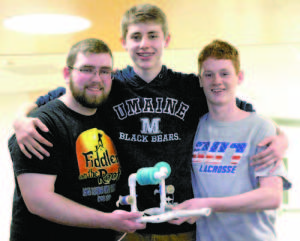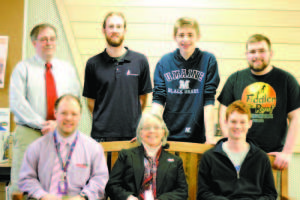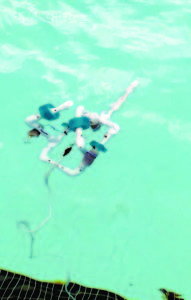Lakers make a splash at robotics competition, headed to Nationals

PLACE THIRD AT STATES was the Lake Region trio of (left to right) Galen McLaughlin, Evan Kellough and Taylor Davis. (Rivet Photo)
Help send Robotics team to Nationals
Lake Region students will need to raise $1,300 to attend the National Seaperch Challenge to be held on May 29–30 at the University of Massachusetts, Dartmouth. Donations or questions regarding the fundraising effort may be sent to team advisor, Joe Dorner, at joe.dorner@lakeregionschools.org or call him at Lake Region High School at 693-6221.
By Wayne E. Rivet
Staff Writer
Taylor Davis likes to design things. Someday, he would like to be an engineer.
Ryan Mccauley had similar aspirations when he was in high school. Today, he is an engineer at Howell Laboratories, Inc., in Bridgton.
The two, along with LRHS students Evan Kellough and Galen McLaughlin, developed a robotic craft that emerged as the third-place winner at a statewide competition held in Bath. The Laker threesome punched a ticket to the national competition next month in Boston.
The winning team credited their success to a partnership between Lake Region H.S. and Howell Labs.
“The experience working with Howell Labs was phenomenal. Ryan (Mccauley, an engineer) could point out this could work or this won’t work, but he also gave us our own space to try things and not tell us what to do, at the same time,†Kellough said.
Mccauley advised and helped students troubleshoot during the design and production phases of the Seaperch project.
“The biggest challenge we faced was the time constraint in the design process. Six to eight weeks from start to finish. It’s a pretty rapid process,†he said. “They (the students) did a great job at adapting.â€
LRHS teacher Joe Dorner said there were three teams that worked with Mccauley, yet what impressed him most was how the students interacted — they were competitive, yet also were willing to help each other.
“All the groups — we had three involved in the Seaperch project — really worked well together. They helped each other, bounced ideas off each other. Their experience from last year really paid off. Hopefully, these students in their first year will come back next year and provide the kind of leadership these guys did this year,†he said.
The project was a perfect example of SAD 61’s educational approach of tapping into the local community to team up professionals who can bring their “real world†skills to the student body.

WINNING PARTNERSHIP — Lake Region H.S. teamed up with Howell Laboratories, Inc. of Bridgton for the Seaperch competition. Pictured are (front, left to right) LR teacher and project advisor Joe Dorner, SAD 61 Assistant Superintendent Deborah Howard, Taylor Davis; (back row) Howell Labs president David Allen, Howell Labs engineer Ryan Mccauley, Evan Kellough and Galen McLaughlin. (Rivet Photo)
“The business partnership SAD 61 has developed with Howell Labs benefits us as a community. I believe an effective education system provides a strong foundation for economic success. Partnering with Howell Labs helps us in achieving that goal,†said Deborah Howard, SAD 61’s assistant superintendent of schools. “This partnership was developed for our students to learn skills related to engineering through robotics. Howell Labs and Lake Region High School staff worked together to make the learning meaningful and successful. Looking forward, I envision this project evolving to include environmental studies related to our local water systems.â€
For the second consecutive year Howell Labs proudly sponsored the LRHS students in a science, technology, engineering and mathematics (STEM) competition called Seaperch.
“Being in the business, we are tied into all the changes that are going on — technology is changing constantly. So, we can bring some of that knowledge to the school and provide them some skills,†said Howell Laboratories, Inc. President David Allen. “We are always hopeful that we can spark the interest of someone who may want to be an engineer some day. We need more engineers, and you hope that the guys and girls will come home and work here. It’s also important that everybody has a background, or at least touches on the knowledge. of these engineering principles and concepts because you don’t have to be an engineer to have that type of technology involved in your life and how it works.â€
Seaperch is named after a decorated World War II submarine, the USS Perch, and is primarily sponsored by the Office of Naval Research (ONR) and managed by the Association for Unmanned Vehicle Systems International (AUVSI) foundation.
Seaperch is an innovative underwater robotics program that equips teachers and students with the resources they need to build an underwater Remotely-Operated Vehicle (ROV) in an in-school or out-of-school setting. Students build the ROV from a kit comprised of low-cost, easily accessible parts, following a curriculum that teaches basic engineering and science concepts with a marine engineering theme.

IN THE POOL — Lake Region's robot in action. Students were able to practice maneuvering the robot thanks to the generosity of Colonial Mast, allowing the use of the pool.
“The biggest challenge we faced was the design process to come up with a robot that can maneuver and have the aerodynamics to move quickly and smoothly,†Davis said. “Buoyancy was key. We didn’t want it to sink, but also not float. We wanted it to be just below the surface of the water so it can move without having to constantly use the motors to go up and down. Having professional help was really important.â€
The Seaperch program provides students with the opportunity to learn about robotics via STEM courseware while building an underwater ROV as part of a science and engineering technology curriculum. Throughout the project, students will learn engineering concepts, problem-solving, teamwork and technical applications.
“The most rewarding (aspect of the project) was building the robot and having it work properly,†McLaughlin said. “We participated in it last year and really enjoyed it. We wanted to do our own design this year. Two changes were arm design and drag so it moves faster through the water. Last year, there was a standard design, which was quite hefty. We slimmed it down so it would move through the water easier and get more force from the motors.â€
Building a Seaperch ROV teaches basic skills in ship and submarine design and encourages students to explore naval architecture and marine and ocean engineering principles. It also teaches basic science and engineering concepts and tool safety and technical procedures. Students learn important engineering and design skills and are exposed to all the exciting careers that are possible in naval architecture and naval, ocean and marine engineering.
Through the generosity of Colonial Mast, students used the indoor pool facility to test the Seaperch ROV and improve their ability to guide the mechanism.
“Using the pool was a big advantage for us because I don’t think other teams had a pool to practice in,†Davis said.
The Northern New England Regional qualifying competition was held in Bath on Saturday, March 28. The event attracted 14 teams from six schools. LRHS entered three teams in the challenge. The all-day competition included vehicle performance (maneuvering and recovery), obstacle course, deep dive, finesse, team and poster presentations, and design evaluation.
The submerged obstacle course involved large rings (22-inches minimum diameter), oriented in any direction, through which the vehicles traveled. Teams navigated through the obstacle course, surfaced, then resubmerged and returned through the course to the end.
At the end of the completion, the LRHS team “KDM†finished in third place, which landed them a chance to advance to the 2015 National Seaperch Challenge in May. At UMass-Dartmouth, the Lakers will face off against 100 other robotic teams.
“The key will be staying focused, and practicing, practicing and practicing. Communication is big. One person navigating, one person listening because with the ripples through the water you don’t get the best angle. One person needs to spot to tell where you are,†Kellough said.
Mccauley agrees that the team needs to be focused and not panic if a “situation†arises, such as a cable “getting stuck on a ring.â€
“The more practice they get with the controls, the better,†he said.
Whatever the outcome, the project was a winner for aspiring engineers like Davis and Mccauley, along with Howell Labs, as they gave back to the local community.
“The whole group was great to work with. The biggest challenge for me was to let them do the design because I often want to get my hands in there and be part of the show. I sat back and let them come up with the ideas, then guided them through mistakes that came up,†Mccauley said. “It’s been a two-way street. It’s been nice to see where they are at and then come see where we are at. It’s been a great partnership.â€

